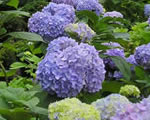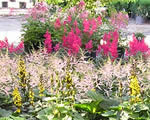
5155
NW 57th Ave
Johnston, Iowa
Click for Directions
Store
Hours
Monday
- Friday
8:00am - 5:00pm
Saturday
8:00am - 4:00pm
Edging in the Landscape
| In the last issue of
the newsletter, we examined the different types of retaining walls
available for residential landscaping. Another essential element
of the landscape is edging. There are five types of edging used
by Miller Nursery: natural, poly, prefabricated concrete, steel,
and limestone.
The basic function of edging is to create a boundary between grass and a planting area. A boundary is necessary to prevent grass from spreading into a planting area and to keep mulch out of the grass. Before deciding on a type of edging, it is important to consider longevity, cost, aesthetics, and installation. Natural edging, a small trench between a planting bed and grass, is very easy to install and very low cost. But natural edging requires a great deal of maintenance. Weeds, leaves, and other yard debris can often litter the natural edge and must be cleaned out frequently. A homeowner who chooses natural edging should be prepared for monthly maintenance to make the edging effective. The most common type of edging is poly. Poly is a black, hard polymer plastic. Miller Nursery only uses a commercial grade. It is significantly stronger than edging found at a home improvement store. Commercial grade is key for the longevity of the edging. Thicker grades of plastic are capable of withstanding more impacts from a lawnmower or line trimmer. Poly edging is very easy to maintain and is cost efficient. A 20-foot strip with a stake kit costs $20. Installation is not difficult, but there are certain techniques that must be followed for the edging to last over time. Poor installation can cause the edging to heave, crack, or break during the freeze/thaw process. Poly will expand and contract as the temperature changes. A commercial grade of poly edging, installed properly should last at least 10 years. Prefabricated concrete edging is rapidly growing in popularity. Miller Nursery uses a product called Classic Edge made by Rockwood. Classic Edge comes in a variety of colors that can be matched to a house or a retaining wall. A piece of Classic Edge is 4 inches wide, 10 inches long, and 4 inches tall. Each piece has a curve on both ends for connection. Classic Edge retails for $1.70 per piece. The obvious advantage of Classic Edge is longevity. Classic Edge will not suffer from the freeze/thaw process and will not be hurt by the lawnmower. Installation is more time consuming than poly edging because it is essential that the pieces interlock properly. There is virtually no maintenance required for Classic Edge. Steel edging is seldom used in residential landscapes. It is very difficult to bend into desirable curves for bed lines. The lack of flexibility makes construction time consuming. And steel edging will rust over time. However, steel edging is more durable than poly edging. It is commonly used in commercial landscaping because it can withstand commercial grade lawnmowers. By far the most expensive type of edging is limestone. It retails for approximately $4 per foot. Installation is very difficult and time consuming because there are many cuts required to create a curve. Limestone will lose its natural color over time and can suffer from the freeze/thaw process. But limestone does have a natural feel and a neutral color. Miller Nursery's landscape designer, Craig Westfield, says that poly and Classic Edge are by far the most popular choices for his customers. This is based on their durability, ease of construction, and low cost. Edging is a necessary part of any landscape, but done properly, it can add to the entire appeal of the garden. |
© Miller Nursery Inc. 2008


